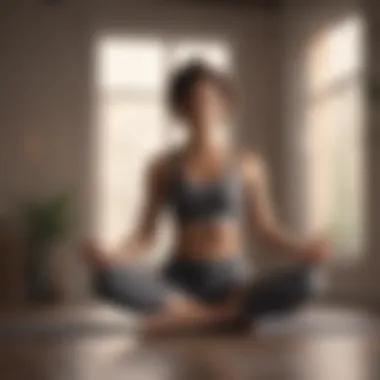Discover Effective Techniques for Relaxing with Anxiety


Research Overview
Anxiety, a prevalent mental health condition, can significantly impact individuals' daily lives. This section delves into exploring effective techniques and strategies aimed at helping individuals relax in the midst of anxiety. By understanding and implementing these relaxation practices, individuals can enhance their overall well-being and quality of life. The section presents evidence-based approaches to reduce anxiety levels and foster a sense of calmness.
Health Implications
The impact of managing anxiety through relaxation techniques has profound implications on health and well-being. By implementing evidence-based strategies to reduce anxiety levels, individuals may experience a notable improvement in their mental and emotional health. This section delves into potential benefits and risks associated with these strategies and provides practical examples on how to incorporate them into daily life.
Well-being Strategies
Practical tips and strategies derived from research findings offer a roadmap for individuals seeking to enhance their well-being amidst anxiety. The section provides insightful advice on how to effectively implement positive changes in daily routines to reduce stress and promote relaxation. Additionally, personal stories and case studies are shared to illustrate the successful application of these strategies in real-life scenarios.
Expert Insights
Expert insights contribute a valuable layer of analysis and understanding to the research findings presented. This section delves into analyzing expert opinions on the effectiveness of various relaxation techniques in managing anxiety. A Q&A session with a relevant expert sheds light on the practical implications of these research findings and offers a deeper understanding of their significance.
In this article, we will delve into various effective techniques and strategies aimed at helping individuals relax amidst anxiety. By mastering methods to manage anxiety through relaxation practices, individuals can significantly enhance their overall well-being and quality of life. These evidence-based approaches can aid in reducing anxiety levels and fostering a sense of calmness in daily experiences.
Understanding Anxiety and Its Impact (300-400 words)
Understanding Anxiety and Its Impact plays a pivotal role in this article by shedding light on the complexities of anxiety and how it influences individuals. By gaining insights into anxiety and its effects, readers can grasp the significance of implementing relaxation techniques. This section will elucidate the multifaceted nature of anxiety, highlighting its relevance to overall well-being and the importance of managing it effectively.
Defining Anxiety (250-300 words)
Types of Anxiety Disorders
When exploring Types of Anxiety Disorders, it is vital to comprehend the diverse manifestations of anxiety that individuals may experience. This facet of the article aims to dissect the key characteristics of various anxiety disorders and their relevance to the overarching theme of relaxation amidst anxiety. Understanding the nuances of different anxiety disorders is crucial as it equips readers with a nuanced understanding of the challenges they may face.
Physical Symptoms of Anxiety
Delving into the Physical Symptoms of Anxiety provides readers with a deep insight into the somatic manifestations of anxiety. By elucidating the physical effects of anxiety, readers can better comprehend the holistic impact of this condition on individuals' well-being. Understanding these symptoms is essential for crafting effective relaxation strategies tailored to address both the mental and physical aspects of anxiety.
The Effects of Anxiety (250-300 words)
Impact on Mental Health
Examining the Impact on Mental Health underscores the profound influence of anxiety on individuals' psychological well-being. This section delves into the intricacies of how anxiety can affect mental health, emphasizing the importance of mitigating these effects through relaxation techniques. By recognizing the impact of anxiety on mental health, readers can seek tailored approaches to alleviate distress and foster emotional resilience.


Impact on Daily Functioning
Exploring the Impact on Daily Functioning sheds light on how anxiety impairs individuals' ability to navigate daily responsibilities and activities. Understanding the operational challenges posed by anxiety is paramount for implementing relaxation strategies that enhance coping mechanisms and boost daily functioning. By addressing these functional impacts, individuals can aspire to lead more balanced and fulfilling lives.
Practical Relaxation Techniques
In this transformative section, we delve into the vital realm of Practical Relaxation Techniques within the context of managing anxiety effectively. Understanding the significance of implementing such techniques is paramount in cultivating inner peace amidst the tumult of anxiety. By embracing these strategies, individuals can pave the way for a calmer mental state and improved overall well-being. Practical Relaxation Techniques serve as invaluable tools in combating anxiety, offering tangible methods to address and alleviate its grip on one's mind and body.
Deep Breathing Exercises
Diaphragmatic Breathing
Diaphragmatic Breathing stands out as a cornerstone in the journey of relaxation and anxiety management. This technique involves focusing on deep, slow breaths that originate from the diaphragm, promoting a sense of calmness and centeredness. The key characteristic of Diaphragmatic Breathing lies in its ability to engage the parasympathetic nervous system, triggering a relaxation response that counters the effects of anxiety. This method is a popular choice for those seeking immediate relief from stress and tension due to its simplicity and effectiveness. Diaphragmatic Breathing's unique feature lies in its ability to regulate breathing patterns, reducing the body's overall stress response. While its advantages are widespread, it may require practice to fully master the technique's nuances.
4-7-8 Technique
The 4-7-8 Technique emerges as a renowned practice in the realm of relaxation and anxiety reduction. By inhaling for 4 seconds, holding the breath for 7 seconds, and exhaling for 8 seconds, individuals can tap into the calming effects of controlled breathing. This technique's key characteristic lies in its ability to synchronize breath and mindfulness, promoting relaxation and inner peace. The 4-7-8 Technique is favored for its simplicity and accessibility, making it a go-to choice for those seeking quick anxiety relief. Its unique feature lies in its ability to regulate oxygen flow, aiding in reducing heart rate and inducing a state of relaxation. While advantageous for immediate tension release, consistent practice is encouraged to yield long-term benefits.
Progressive Muscle Relaxation
Developing Patterns Directive Food Measure
Purchase yourself
Step-by-Step Relaxation Process
Embarking on the Step-by-Step Relaxation Process unveils a structured approach to releasing tension and promoting relaxation. This technique involves systematically tensing and then relaxing different muscle groups, heightening awareness of bodily sensations and promoting overall calmness. The key characteristic of this process lies in its ability to promote relaxation awareness. The methodology's uniqueness is in its progressive nature, guiding individuals through a sequential release of muscle tension. The advantages of the Step-by-Step Relaxation Process include enhancing body-mind connection and reducing physical symptoms of stress. While highly beneficial, individuals may face challenges in mastering the sequential muscle relaxation technique.
Tension Release Techniques
Tension Release Techniques play a pivotal role in alleviating stress and anxiety, offering targeted methods to unwind and release pent-up tension. By incorporating techniques such as stretching, self-massage, and visualization, individuals can actively combat the physical manifestations of anxiety. The key characteristic of these techniques lies in their ability to provide immediate relief from muscle tension, promoting relaxation and rejuvenation. Their popularity stems from the diverse approaches available, catering to various preferences and comfort levels. The unique feature of Tension Release Techniques is their holistic approach to relaxation, addressing both physical and mental tension. While advantageous for stress relief, consistency in practice is essential to reap lasting benefits.
Mindfulness Meditation
Essentials Principles Principle Airplane Order Ante Bank Techniques Vegetable Begin
Beacons London


Focused Attention Meditation
Engaging in Focused Attention Meditation allows individuals to cultivate mindfulness and presence, redirecting attention to the present moment and fostering inner peace. This method's key characteristic is its focus on single-pointed concentration, guiding practitioners to observe thoughts and sensations without judgment. Focused Attention Meditation is revered for its ability to enhance mental clarity and reduce anxiety by anchoring awareness in the present. Its unique feature lies in its simplicity and adaptability, making it suitable for meditation beginners. While advantageous in promoting focus and tranquility, consistent practice is essential to harness the full benefits of this meditation style.
Body Scan Meditation
Body Scan Meditation offers a profound journey into relaxation by systematically scanning and relaxing different parts of the body, bringing awareness to physical sensations and promoting deep relaxation. The key characteristic of this meditation practice lies in its ability to foster body awareness and release tension from head to toe. Body Scan Meditation is a favorable choice for individuals seeking to unwind and reconnect with their physical selves due to its deeply calming effects. Its unique feature lies in its potential to uncover areas of tension and promote overall relaxation throughout the body. While advantageous in promoting physical and mental relaxation, patience and consistency are key to fully embracing the benefits of Body Scan Meditation.
Incorporating Relaxation into Daily Routine
When it comes to dealing with anxiety, incorporating relaxation techniques into your daily routine is key. By establishing a consistent practice of relaxation, individuals can effectively manage their anxiety levels and promote a sense of inner calmness amidst the chaos of everyday life. This aspect of the article delves into the significance of integrating relaxation into daily activities, emphasizing the long-term benefits of such a practice for overall well-being and mental health.
Setting Aside Relaxation Time
Creating a Relaxation Schedule
Creating a relaxation schedule is a fundamental aspect of incorporating relaxation into your daily routine. This structured approach allows individuals to allocate specific intervals for relaxation, ensuring that they prioritize self-care amidst their busy schedules. Noteworthy for its organization and efficacy, creating a relaxation schedule enables individuals to proactively address their anxiety triggers and dedicate time solely for relaxation activities. The predictability of a relaxation schedule fosters consistency, which is vital in cultivating a healthy mindset and reducing anxiety levels over time. Although it may require initial adjustments, the benefits of a relaxation schedule in this article are plentiful, offering a reliable framework for managing anxiety and improving overall quality of life.
Prioritizing Self-Care
Prioritizing self-care is a pivotal component of the relaxation process within the context of this article. By making self-care a top priority, individuals can nurture their well-being and mental health, ultimately enhancing their ability to cope with anxiety. This deliberate focus on self is crucial for establishing a strong foundation for relaxation practices, as it reinforces the importance of self-nourishment and personal growth. The act of prioritizing self-care involves recognizing one's needs and allocating time and resources accordingly, demonstrating a commitment to self-improvement and inner peace. While the dedication to self-care may require a shift in mindset, the advantages of prioritizing self-care in this article are substantial, promoting resilience against anxiety and encouraging sustainable relaxation habits.
Utilizing Relaxation Apps and Tools
Integrating technology into relaxation practices can significantly enhance the effectiveness of anxiety management. Utilizing relaxation apps and tools provides individuals with convenient and accessible resources to support their relaxation journey. This section explores the benefits of incorporating relaxation apps and tools into daily routines, highlighting their ability to streamline relaxation techniques and amplify their impact on mental well-being.
Top Relaxation Apps
Top relaxation apps are invaluable companions for individuals seeking structured guidance and support in relaxation exercises. These apps offer a diverse range of features, from breathing exercises to guided meditations, catering to various preferences and goals. Their user-friendly interfaces and customizable settings make relaxation apps a popular choice for those navigating anxiety and stress. The unique feature of top relaxation apps lies in their ability to track progress and adapt to individual needs, providing a personalized experience that promotes consistency and growth in relaxation practices. While some may find dependence on technology a drawback, the advantages of top relaxation apps in this article are evident, offering tailored solutions for anxiety management and sustainable well-being.
Guided Imagery Resources
Guided imagery resources serve as powerful tools in promoting relaxation and alleviating anxiety symptoms. Through visualization and sensory stimulation, guided imagery resources allow individuals to engage their minds in calming scenarios, diverting attention from stressors and fostering a sense of tranquility. The efficacy of guided imagery lies in its ability to evoke positive emotions and reduce tension in both mind and body, making it a valuable asset in anxiety management. The unique feature of guided imagery resources is their versatility, catering to different preferences and styles of relaxation. Despite possible limitations in effectiveness for certain individuals, the advantages of guided imagery resources in this article are considerable, offering a creative outlet for relaxation and emotional regulation.
Professional Support and Further Resources
Professional support and further resources play a vital role in enhancing one's journey to managing anxiety. Seeking assistance from trained professionals can provide individuals with tailored strategies and interventions that are evidence-based. These resources offer a structured approach to addressing anxiety symptoms and developing coping mechanisms. Moreover, professionals can offer personalized guidance and support, empowering individuals to navigate their anxiety more effectively. Additionally, further resources such as support groups and online platforms can offer continuous assistance and community connection.


Therapeutic Interventions
Cognitive-Behavioral Therapy
Cognitive-Behavioral Therapy (CBT) is a cornerstone therapeutic intervention in managing anxiety. It focuses on identifying and altering negative thought patterns and behaviors that contribute to anxiety. The structured nature of CBT allows individuals to challenge their maladaptive beliefs systematically, leading to long-lasting changes in how they perceive and respond to anxiety triggers. The collaborative approach of CBT fosters self-awareness and equips individuals with practical skills to regulate their emotions and actions. While the effectiveness of CBT is well-documented, its time-intensive nature and the need for consistent practice are essential considerations for individuals pursuing this therapy.
Exposure Therapy
Exposure Therapy is another key therapeutic intervention that aids individuals in confronting their fears gradually. By exposing oneself to anxiety-inducing stimuli in a controlled environment, individuals can learn to build resilience and reduce their overall anxiety responses. Exposure Therapy works on the principle of desensitization, where repeated exposure leads to decreased fear and avoidance behavior. This structured approach enables individuals to confront their anxieties in a safe and supportive setting. While Exposure Therapy can be highly effective, it may provoke temporary distress in individuals during the exposure process.
Online Therapy Platforms
Benefits of Virtual Counseling
Virtual counseling offers convenient access to therapeutic support from the comfort of one's environment. It eliminates geographic barriers and provides individuals with a wider range of mental health professionals to choose from. The flexibility of virtual counseling accommodates hectic schedules and promotes consistent engagement in therapy. Moreover, the anonymity of online platforms can reduce stigma related to seeking mental health support, encouraging more individuals to access help when needed.
Accessing Online Support Groups
Online support groups create a supportive community for individuals experiencing anxiety. These groups offer a space for sharing experiences, coping strategies, and emotional support. By connecting with peers facing similar challenges, individuals can feel less isolated and more understood. Participation in online support groups fosters a sense of belonging and encourages mutual empowerment in managing anxiety. While online support groups provide valuable communal support, individuals should be cautious of misinformation and ensure the credibility of the group and its facilitators.
Lifestyle Adjustments for Stress Management
In this article, the section on Lifestyle Adjustments for Stress Management emerges as a crucial aspect of understanding how to mitigate anxiety and enhance overall well-being. Lifestyle adjustments hold a pivotal role in managing daily stressors and fostering a balanced lifestyle conducive to mental health. By incorporating strategic changes in various aspects of one's routine, individuals can proactively address stress triggers and promote resilience against anxiety. This section sheds light on the significance of adopting healthy habits and making deliberate choices to promote stress management.
Healthy Sleep Practices
Sleep Hygiene Tips
Within the realm of healthy sleep practices, the focus on Sleep Hygiene Tips is paramount to this article's goal of combating anxiety through relaxation techniques. Sleep hygiene tips encompass a range of practices aimed at optimizing one's sleep environment and routines to ensure restful and rejuvenating sleep. The key characteristic of these tips lies in their emphasis on creating a conducive sleep environment by regulating light exposure, noise levels, and bedtime habits. This targeted approach not only improves sleep quality but also plays a vital role in alleviating anxiety symptoms. Despite their efficacy, the challenge may lie in consistently implementing and adhering to these tips, requiring dedication and discipline to reap their benefits fully.
Relaxing Bedtime Routines
Another integral component of healthy sleep practices, Relaxing Bedtime Routines, complements the aforementioned sleep hygiene tips in promoting relaxation and anxiety reduction. A distinguishing feature of bedtime routines is their ability to signal the body and mind that it is time to unwind and prepare for rest. These routines typically involve activities that induce a sense of calmness, such as reading a book, practicing gentle stretches, or listening to soothing music. While their advantages in promoting relaxation are evident, individuals may face challenges in finding the most suitable routine that aligns with their preferences and schedules. It is essential to customize bedtime routines to cater to individual needs and ensure optimal effectiveness in managing anxiety.
Physical Activity and Anxiety Reduction
Benefits of Exercise for Anxiety
The discussion on the Benefits of Exercise for Anxiety underscores the profound impact of physical activity on mental well-being and anxiety management. Engaging in regular exercise not only promotes physical health but also triggers the release of endorphins, the body's natural stress relievers. The key characteristic of exercise in anxiety reduction is its ability to increase dopamine levels, elevate mood, and reduce feelings of anxiety and tension. This makes it a popular and beneficial choice in addressing anxiety symptoms holistically. However, individuals need to be mindful of personal limitations and exercise preferences to integrate suitable workout routines effectively into their anxiety management strategies.
Choosing Suitable Physical Activities
When exploring Physical Activity and Anxiety Reduction, the emphasis on Choosing Suitable Physical Activities is pivotal in tailoring an exercise regimen to individual needs and preferences. The key characteristic of this aspect lies in selecting activities that resonate with one's interests, fitness level, and comfort, ensuring a sustainable and enjoyable exercise experience. By choosing activities that align with personal preferences, individuals are more likely to stay motivated and consistent in their exercise routine, thereby reaping the anxiety-reducing benefits. Despite its advantages, the challenge lies in finding the right balance between challenging oneself and avoiding overwhelming physical exertion, emphasizing the importance of listening to one's body and adjusting activities accordingly.



